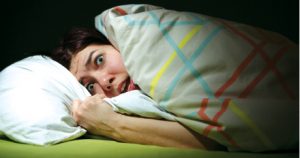NEUROFEEDBACK CAN HELP
 Many of us experience interruptions in a good night’s sleep. Crying babies, little ones climbing into bed with you, animals wanting your attention at night, life/work stress or partners stealing the covers are usually the cause. But when your sleep is disrupted by nightmares or night terrors, there is more going on here than an occasional bad night of sleep. What exactly are nightmares or night terrors and what is the difference?
Many of us experience interruptions in a good night’s sleep. Crying babies, little ones climbing into bed with you, animals wanting your attention at night, life/work stress or partners stealing the covers are usually the cause. But when your sleep is disrupted by nightmares or night terrors, there is more going on here than an occasional bad night of sleep. What exactly are nightmares or night terrors and what is the difference?
According to the Mayo Clinic (April 23, 2021) sleep terrors are episodes of screaming, intense fear and flailing while still asleep. Also known as night terrors, sleep terrors often are paired with sleepwalking. Like sleepwalking, sleep terrors are considered a parasomnia – an undesired occurrence during sleep.
The Mayo clinic describes a nightmare as a disturbing dream associated with negative feelings, such as anxiety or fear that awakens you. (June 5, 2021).
While having an occasional sleep disturbance of a nightmare or night terror is considered normal, experiencing these events often can be the sign of disruption in the brain.
WHAT IS HAPPENING IN THE BRAIN TO CAUSE NIGHTMARE / NIGHT TERRORS?
Very often we hear nightmares or sleep/night terrors described or diagnosed as a manifestation of trauma. Although this may be correct in some instances, it is not the case in all. The common dominator, in all cases of extreme sleep disturbance, points to the brain and neuron firing.
When neurons are over-active, chaotic, extremely disorganized or severely imbalanced in the brain, the result is very often a sleep disturbance. Additionally, we typically see this disturbance of the neuron pattern towards the back of the brain in the parietal lobe.
In this example, GREEN indicates normal (mean) neuron firing. YELLOW indicates neuron firing approximately 1 standard deviation above the normal, ORANGE indicates approximately 2 standard deviations above normal, and the RED indicates approximately 3 standard deviations above normal.
Neuron firing is grouped by speed (Hz) so Delta (1-5), Theta (4-7), and Alpha (8-11) are considered slower firing neurons; Beta (12-18) is faster but no too fast and is considered a “working/thinking” wave, and High Beta (19-40) neurons are considered “fast” activity in the brain and are prominent when we are stressed, anxious, excited, traumatized, etc.
We have all these patterns firing in our brain on a consistent basis, making up the billions of neuron signals happening at any given point in time. When we record a QEEG (Quantitative EEG), the brain is asked to shift into a neutral brain state, where you are awake but relaxed and focused, if the firing in parts of the brain, do not shift or reduce to this neutral state, we can see that in the QEEG as indicated in the picture above.
When parts of your brain struggle to shift into neutral in this recording, we can then ascertain that the brain isn’t shifting into a peaceful, restful, or relaxing state at night. This inability to shift typically results in sleep disturbances such as nightmares and/or night terrors.
Neurofeedback can help.
WHAT IS NEUROFEEDBACK?
Neurofeedback has been studied and practiced since the late 60’s. It is exercise for your brain; allowing you to see the frequencies produced by different parts of your brain in real-time and then through visual and auditory feedback, teaches the brain to better regulate itself. Neurofeedback can be used to help detect, stimulate, and/or inhibit activity in the brain safely and without medication. It can help restore a wider “range of motion” in brain states, much like physical therapy does for the body.
While the client sits comfortably watching a movie or pictures appear on the screen (a calm and focused state), the EEG equipment measures the frequency or speed at which electrical activity moves in the areas where electrodes have been placed. This information is sent to the therapist’s computer. The therapist is then able to determine what frequencies are out of balance. For example, when the EEG shows that you are making too many “slow” or “sleepy” waves (delta/theta) or too many “fast” waves (high beta), the therapist adjusts a reward band (on the therapist’s screen) to encourage more balanced activity. This encouragement or “reward” happens through an auditory reinforcement of “beeps” and sometimes through visual reinforcement of changes on the client’s screen.
It is important to understand that the neurofeedback approach does not “cure” or “fix” your brain. We teach and guide your brain to produce frequencies which help it relax and/or focus. We provide the brain with gentle “challenges” and encouragement in a user-friendly, stress-free format so it learns to regulate or shift to healthier states more smoothly on its own at the appropriate time.
HOW DOES A “BEEP” OR SOUND TRAIN MY BRAIN TO WORK BETTER?
The auditory or sound reward that corresponds to an increase or decrease in desired brainwave activity can affect the brain on a neurological level. Auditory reward stimulates auditory pathways, impacts the vestibular system, and has many connections to the reticular activating system, which modulates wakefulness and attention. These systems operate in our brains without conscious effort. Therefore, neurofeedback teaches your brain through automated learning with little or no behavioral effort. Another way to say this is that neurofeedback involves operant conditioning or learning. This type of learning teaches us through a reinforced reward system. The auditory reward (beep) is delivered on a schedule of reinforcement that promotes optimal learning; not too hard and not too easy. This schedule of reinforcement or reward provides just the right amount of resistance to evoke a positive learning pattern.
HOW MANY SESSIONS ARE NEEDED
TO BEGIN SEEING RESULTS?
As the brain learns, you will see the changes. However, everyone learns at different speeds, so it cannot be determined how quickly someone will learn. On average, children take about 10-20 sessions to see changes and we can discuss what to expect during the intake appointment. For adults changes are usually noticed within 10 sessions. Total treatment is an average of 40 sessions; however we individualize all aspects of treatment and find that some people need more and some less.
WHAT IS A QEEG (QUANTITATIVE EEG) OR BRAIN MAP AND DO I NEED ONE?
The QEEG is a quantitative EEG. It’s also called a brain map and does just that…it gives us a map of what is going on with the entire brain at one time. We attach electrodes to the whole head, 19 spots, and then record the brain waves with his eyes open for 5 minutes and with his eyes closed for 10 minutes. This recording is then sent to Advanced Psychological Services in North Carolina to be read and analyzed. They can not only give us a summary of significant findings, but the report also shows the results of analyzing the data several different ways. The brain activity is not only compared spot by spot over the entire head, but we can also look at connections, symmetry, how different parts are communicating, and all this data is compared to a database of peers (same sex, handedness and age). It can help us see what areas need to be addressed more efficiently than just training spot by spot.
We don’t always need this data to make an improvement in symptoms, but we do recommend it in certain situations. A QEEG can also be helpful information when diagnosing and/or trying to decide the best medication/supplement recommendations.
DOES NEUROFEEDBACK HURT?
Neurofeedback is a non-invasive, non-medication, and most importantly a non-painful approach. Your experience will be very relaxing and positive. We gently teach your brain how to regulate more efficiently and do not force your brain into a brain state that is not comfortable.
IS THERE ENOUGH RESEARCH?
Neurofeedback has been researched since the 60’s. Here are some resources for research. We have several journal articles, studies, and books in our office for you to enjoy, however because of the amount of information out there, we cannot possibly have everything. Here are a few resources.
Look up the work of:
Dr. Joe Kamiya and Dr. Barry Sterman (Credited for earliest development of Neurofeedback).
Look for specific researched conditions:
https://www.eeginfo.com
https://www.isnr.org
Print Resources:
Journal of Neurotherapy
NeuroRegulation Journal
Applied Psychophysiology and Biofeedback
Books:
A Symphony in the Brain by Jim Robbins
Healing Young Brains by Robert Hill & Eduardo Castro
The Healing Power of Neurofeedback by Stephen Larsen
Neurofeedback in the Treatment of Developmental Trauma by Sebern Fisher
Neurofeedback 101: Rewiring the Brain for ADHD, Anxiety, Depression and Beyond (without medication) by Michael P. Cohen
HOW DO I GET STARTED?
Getting started is easy, just give us a call. The Brain and Wellness Center staff will answer all of your questions, and help you get scheduled. If you are wondering what services are best for you? We can help determine that at the time of the intake or in a FREE scheduled telephone consultation. Call, email or message us today! Brain and Wellness Center, 7301 W. Palmetto Park Rd., Suite 102A, Boca Raton, FL 33433. (561) 206-2706, e-mail us at info@bocabraincenter.com, or text us at (561) 206-2706 or visit our website at
www.BocaBrainCenter.com.
Renee Chillcott, LMHC
Renee Chillcott is a Licensed Mental Health Counselor that has been practicing Neurofeedback training since 2005. Renee holds a BA degree from The University of Central Florida and a Master’s Degree in Psychology/Mental Health Counseling from Nova Southeastern University. She is a Licensed Mental Health Counselor and is the owner/operator of The Brain and Wellness Center, located in Boca Raton. At the Brain and Wellness Center, adults, teens, children and families enjoy a variety of services from multiple providers. Neurofeedback, Brain Mapping, SSP, EMDR, Learning Programs, and counseling are among a few of the services offered.
Brain and Wellness Center
7301 W. Palmetto Park Rd.
Suite 102A, Boca Raton, FL 33433
(561) 206-2706
www.BocaBrainCenter.com
 South Florida Health and Wellness Magazine Health and Wellness Articles
South Florida Health and Wellness Magazine Health and Wellness Articles




